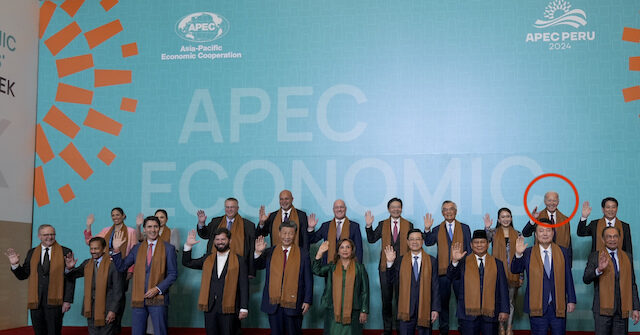During his anticipated final international trip as president, Joe Biden has faced a series of public relations blunders, including an awkward exit into the Amazon Rainforest and being snubbed in group photos at the G20 and APEC summits. Biden’s journey included stops in Lima, Peru, and Rio de Janeiro, Brazil, where he attended both the G20 and the APEC forum. Notably, at the APEC summit, Biden held an extended meeting with Chinese President Xi Jinping, who reportedly used the occasion to lecture the American president on issues such as democracy and human rights, which Beijing typically views as off-limits for discussion.
The APEC summit brought together leaders from Pacific Ocean nations, including several from Southeast Asia and South America. As part of the summit’s customary practices, attendees took a “family photo.” However, instead of the usual central position, Biden found himself in the back row, overshadowed by Xi. Reports indicated that Biden arrived late, as documented in video footage showing Xi and other leaders poised for the photo. This moment was particularly symbolic, with Xi taking a prominent position alongside leaders from Peru and Chile, further emphasizing the shifting dynamics of power within international relations.
At the G20 summit in Brazil, Biden’s absence was again notable as photographers proceeded to capture a group photo without waiting for him, echoing the earlier incident in Lima. Alongside Biden, Canadian Prime Minister Justin Trudeau and Italian Prime Minister Giorgia Meloni also missed the photo opportunity, though the three leaders later gathered for a separate picture. The G20 photo featured Xi in a central position again, surrounded by leftist figures, which drew scrutiny in the context of global leadership discussions. In response to the negative press, unnamed senior Biden administration officials attributed Biden’s absence to “logistical issues,” downplaying the situation as a mere mishap.
The media’s coverage of these moments highlighted a growing sentiment of unease regarding Biden’s leadership. American journalists expressed their dismay at Biden’s apparent disorganization during the photo sessions, with some reporters humorously noting his unintentional hiding behind a palm tree during the G20 photo shoot—an image that has since fuelled late-night comedy sketches and critiques. The situation has tainted the perception of Biden’s diplomatic effectiveness amid ongoing challenges that America faces both domestically and on the international stage.
Outside the two summits, Biden’s visit to Manaus, Brazil, drew attention not just for its substance but also for its optics. While he aimed to showcase America’s investment in international climate financing, Biden’s seemingly aimless foray into the Amazon forest after addressing reporters became a talking point on social media and in comedy shows. The White House heralded his efforts and commitment to climate initiatives as a “historic climate legacy,” yet the visual representation of Biden wandering off detracted from the intended narrative of diplomatic success.
In his meeting with Xi, however, the exchange was more serious, with Xi reportedly seizing the opportunity to reiterate China’s “red lines.” These red lines, detailed by Chinese state media, include issues surrounding Taiwan, China’s political system, and its environmental stances. This context illustrates the complexities and tensions that underpin U.S.-China relations as Biden attempts to navigate a landscape fraught with geopolitical challenges. Observations from the G20 summit indicated apprehension among leftist leaders concerning a possible realignment of global priorities with the election of Donald Trump, suggesting that Biden’s leadership may face growing skepticism both at home and abroad as he nears the end of his presidency.

